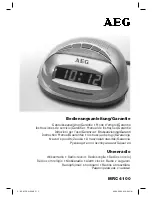
8
Connecting Inlet Power, Input and Output Signals
3.2
Low DC, Power Supply Inlet
The low DC supply accepts 22 Vdc to 67 Vdc ONLY (
<
30 VA typical) and uses the same three-
terminal inlet connector as the Universal High Voltage Supply. This power supply inlet can be
located in a position labeled
POWER A
or
POWER B
on the rear panel. See Figure 3.2.
Figure 3.2: Low DC Power Supply Inlet Connector
DC+ DC- GND
22-67 VDC
<30W TYPICAL
DC ONLY
3.2.1
Low DC: Connecting Inlet Power
The terminals are labeled as DC+, DC- and GND. DC+ is the positive lead, DC- is the negative
lead, and GND is ground.
Strip the inlet wire 6 mm (1/4 in) and DO NOT TIN the bare wire with solder. Insert each
wire into the appropriate terminal and tighten the set screws clockwise to secure. When connecting
power to the clock, connect the ground lead first.
When wiring station batteries to this power supply, make sure to first connect an earth ground
wire to the station ground. Then connect the positive and negative leads to the appropriate battery
terminals.
The clock has no power switch. It becomes energized with the application of power.
3.2.2
Surge Withstand Protection
Both the Universal and Low DC power supplies provide input surge withstand protection (SWC)
for compliance with ANSI C37.90-1 and IEC 801-4.
3.3
Power Supply Fuses, Types and Ratings
Use the fuse table below for identifying the correct fuse for your power supply.
Power Supply
Fuse Part No.
Fuse Specifications
Size, diameter
×
length
Universal
FU0003001
3.15 A, 500 V, Time Lag, no leads
5 mm
×
20 mm
Low DC Only
FU0003100
8.0 A, 500 V, Time Lag, no leads
5 mm
×
20 mm
Table 3.1: Fuse Chart
3.3.1
Replacing Fuses
The fuse compartment is located on the left side of each inlet connector. Fuses for Power A and
Power B are located in separate compartments. To check or replace each fuse, first disconnect inlet
power from the clock. Use a medium, flat-bladed screwdriver push in and turn counter-clockwise.
The cover and fuse should pop out.
















































